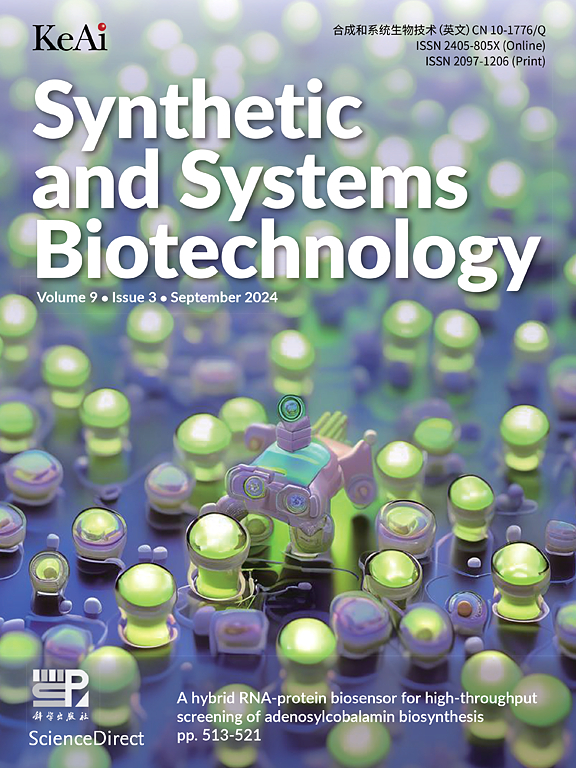通过酿酒酵母系统代谢工程提高葡萄糖产绿原酸
IF 4.4
2区 生物学
Q1 BIOTECHNOLOGY & APPLIED MICROBIOLOGY
引用次数: 0
摘要
绿原酸(Chlorogenic acid, CGA)是一种具有多种药用功能的珍贵酚酸。在我们之前的研究中,我们已经在酿酒酵母中实现了CGA的从头合成。然而,在大规模生产之前,其收率需要提高。本研究采用系统代谢工程策略对底盘细胞S. cerevisiae YC0707进行改造,以提高其产葡萄糖CGA的产量。为了平衡磷酸烯醇丙酮酸(PEP)和4-磷酸红酶(E4P)的供应,ZWF1(编码葡萄糖-6-磷酸脱氢酶)和GND1(编码6-磷酸葡萄糖酸脱氢酶)通过强启动子PTEF1交换而过表达,从而加强了戊糖磷酸途径。进一步引入磷酸果糖激酶突变体(PFK2S718D)来削弱糖酵解途径。然后,利用粘红酵母(RgTAL)、ΔHAM1和ΔYJL028W中的酪氨酸解氨酶提高对香豆酸的合成能力。AtC4H(肉桂酸-4-羟化酶)和At4CL1(4-香豆酸辅酶a连接酶1)以及CsHQT(羟基肉桂酸辅酶a醌酸转移酶)和AtC3'H(对香豆油酸3-羟化酶)的融合表达提高了CGA的生物合成通量。随后,通过过表达INO2(脂质生物合成转录因子)和去除血红素加氧酶基因HMX1,改善了P450酶的微环境。此外,筛选潜在的转运蛋白以促进CGA的积累。最后,对发酵条件进行了优化。使用这些策略,CGA滴度在摇瓶中从234.8 mg/L增加到837.2 mg/L,在5-L生物反应器中达到1.62 g/L,这是在cerevisiae中报道的最高滴度,为CGA的生产提供了新的见解。本文章由计算机程序翻译,如有差异,请以英文原文为准。

Enhanced chlorogenic acid production from glucose via systematic metabolic engineering of Saccharomyces cerevisiae
Chlorogenic acid (CGA) is a valuable phenolic acid with various pharmaceutical functions. In our previous study, de novo synthesis of CGA in Saccharomyces cerevisiae was achieved. However, its yield required improvement before large scale production. In this study, systematic metabolic engineering strategy was used to reconstruct chassis cell S. cerevisiae YC0707 to enhance its CGA yield from glucose. To balance the supply of phosphoenolpyruvate (PEP) and erythrose 4-phosphate (E4P), ZWF1 (encoding glucose-6-phosphate dehydrogenase) and GND1 (encoding 6-phosphogluconate dehydrogenase) were overexpressed by strong promoter PTEF1 swapping, thereby strengthening the pentose phosphate pathway. The mutant of phosphofructokinase (PFK2S718D) was further introduced to weaken the glycolytic pathway. Then, the p-coumaric acid synthesis capacity was enhanced by employing tyrosine ammonia lyase from Rhodotorula glutinis (RgTAL), ΔHAM1, and ΔYJL028W. Fusion expression of AtC4H (cinnamate-4-hydroxylase) and At4CL1 (4-coumarate CoA ligase 1), together with CsHQT (hydroxycinnamoyl CoA quinate transferase) and AtC3′H (p-coumaroyl shikimate 3-hydroxylase), improved biosynthetic flux to CGA. Subsequently, the microenvironment of P450 enzymes was improved by overexpressing INO2 (a transcription factor for lipid biosynthesis) and removal of heme oxygenase gene HMX1. Furthermore, screening potential transporters to facilitate CGA accumulation. Finally, we optimized the fermentation conditions. Using these strategies, CGA titers increased from 234.8 mg/L to 837.2 mg/L in shake flasks and reached 1.62 g/L in a 5-L bioreactor, representing the highest report in S. cerevisiae and providing new insights for CGA production.
求助全文
通过发布文献求助,成功后即可免费获取论文全文。
去求助
来源期刊

Synthetic and Systems Biotechnology
BIOTECHNOLOGY & APPLIED MICROBIOLOGY-
CiteScore
6.90
自引率
12.50%
发文量
90
审稿时长
67 days
期刊介绍:
Synthetic and Systems Biotechnology aims to promote the communication of original research in synthetic and systems biology, with strong emphasis on applications towards biotechnology. This journal is a quarterly peer-reviewed journal led by Editor-in-Chief Lixin Zhang. The journal publishes high-quality research; focusing on integrative approaches to enable the understanding and design of biological systems, and research to develop the application of systems and synthetic biology to natural systems. This journal will publish Articles, Short notes, Methods, Mini Reviews, Commentary and Conference reviews.
 求助内容:
求助内容: 应助结果提醒方式:
应助结果提醒方式:


